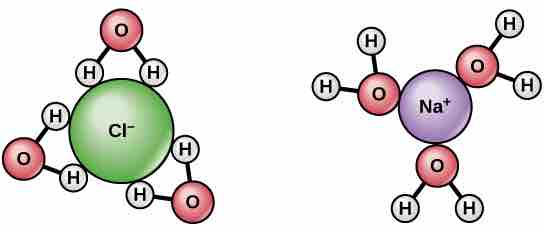Water's Solvent Properties
Water, which not only dissolves many compounds but also dissolves more substances than any other liquid, is considered the universal solvent. A polar molecule with partially-positive and negative charges, it readily dissolves ions and polar molecules. Water is therefore referred to as a solvent: a substance capable of dissolving other polar molecules and ionic compounds. The charges associated with these molecules form hydrogen bonds with water, surrounding the particle with water molecules. This is referred to as a sphere of hydration, or a hydration shell, and serves to keep the particles separated or dispersed in the water.
When ionic compounds are added to water, individual ions interact with the polar regions of the water molecules during the dissociation process, disrupting their ionic bonds. Dissociation occurs when atoms or groups of atoms break off from molecules and form ions. Consider table salt (NaCl, or sodium chloride): when NaCl crystals are added to water, the molecules of NaCl dissociate into Na+ and Cl– ions, and spheres of hydration form around the ions. The positively-charged sodium ion is surrounded by the partially-negative charge of the water molecule's oxygen; the negatively-charged chloride ion is surrounded by the partially-positive charge of the hydrogen in the water molecule.

Dissociation of NaCl in water
When table salt (NaCl) is mixed in water, spheres of hydration form around the ions.
Since many biomolecules are either polar or charged, water readily dissolves these hydrophilic compounds. Water is a poor solvent, however, for hydrophobic molecules such as lipids. Nonpolar molecules experience hydrophobic interactions in water: the water changes its hydrogen bonding patterns around the hydrophobic molecules to produce a cage-like structure called a clathrate. This change in the hydrogen-bonding pattern of the water solvent causes the system's overall entropy to greatly decrease, as the molecules become more ordered than in liquid water. Thermodynamically, such a large decrease in entropy is not spontaneous, and the hydrophobic molecule will not dissolve.